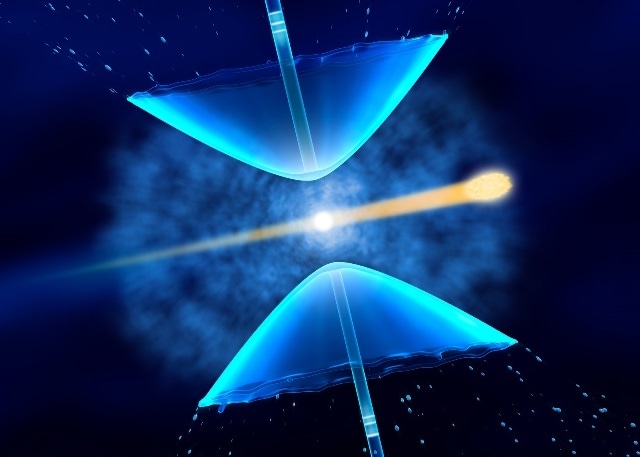May 25 2016
Researchers at the Department of Energy’s SLAC National Accelerator Laboratory have for the first time developed microscopic movies depicting the vaporization of liquids by an X-ray laser, which is considered to be the brightest in the world.
 This illustration shows how an ultrabright X-ray laser pulse (orange beam) vaporizes part of a liquid jet (blue), creating umbrella-shaped films of liquid and sending shock waves through the jet (bright stripes at top and bottom). (SLAC National Accelerator Laboratory)
This illustration shows how an ultrabright X-ray laser pulse (orange beam) vaporizes part of a liquid jet (blue), creating umbrella-shaped films of liquid and sending shock waves through the jet (bright stripes at top and bottom). (SLAC National Accelerator Laboratory)
“Understanding the dynamics of these explosions will allow us to avoid their unwanted effects on samples,” says Claudiu Stan of Stanford PULSE Institute, a joint institute of Stanford University and SLAC. “It could also help us find new ways of using explosions caused by X-rays to trigger changes in samples and study matter under extreme conditions. These studies could help us better understand a wide range of phenomena in X-ray science and other applications.”
Caught on Camera: X-ray Laser Makes a Splash
Liquids are considered to be a universal way of introducing samples into the path of the X-ray beam for investigation at SLAC’s Linac Coherent Light Source (LCLS), a DOE Office of Science User Facility, along with other X-ray lasers. Ultrabright X-rays are capable of blowing up samples within a few seconds when the power is full. In most cases, researchers acquire the data needed by them before the occurrence of damage.
A recent study featured in Nature Physics explains in detail how the explosive interaction unfolds and offers clues explaining how it could impact the laser experiments.
Stan and his research team explored two methods of injecting liquid into the X-ray laser’s path: as a continuous jet or as a series of individual drops. For every single X-ray pulse striking the liquid, Stan’s team obtained a single image, which was timed from five billionths of a second to one ten-thousandth of a second following the pulse. Hundreds of these snapshots were then strung together into movies.
Thanks to a special imaging system developed for this purpose, we were able to record these movies for the first time. We used an ultrafast optical laser like a strobe light to illuminate the explosion, and made images with a high-resolution microscope that is suitable for use in the vacuum chamber where the X-rays hit the samples.
Sébastien Boutet, LCLS
The researchers have developed footage that demonstrates the splitting of a liquid drop by an X-ray pulse. This results in a cloud of extremely small particles and vapor that spreads towards nearby drops, causing damage to the drops. All of these damaged drops proceed toward the neighboring drops and combine with them.
As far as jets are concerned, the movies highlight how a hole is initially punched into a liquid stream by the X-ray pulse. Persistent growth is detected in this gap and a thin liquid film is formed on the ends of the jet lying on either side of the gap. This causes the film to develop in the shape of an umbrella, and then folds back and integrates with the jet.
Predicting Future Challenges and Opportunities
The researchers, based on the data collected by them, created mathematical models that precisely explain the explosive behavior for a variety of factors that researchers contrast from one LCLS experiment to another, also including jet diameter, drop size and pulse energy.
The research team was also able to predict how the formation of gaps in jets could give rise to a challenging situation in experiments conducted at the future light sources European XFEL in Germany and LCLS-II, under construction at SLAC. These two next-generation X-ray lasers will be capable of firing thousands of times faster than the existing facilities.
The jets in our study took up to several millionths of a second to recover from each explosion, so if X-ray pulses come in faster than that, we may not be able to make use of every single pulse for an experiment. Fortunately, our data show that we can already tune the most commonly used jets in a way that they recover quickly, and there are ways to make them recover even faster. This will allow us to make use of LCLS-II’s full potential.
Claudiu Stan, Stanford PULSE Institute
For the very first time, the movies show how an X-ray blast develops shock waves that swiftly pass through the liquid jet. The researchers believe that these data could prove useful in unique experiments, in which shock waves from a single X-ray pulse trigger changes in a sample probed by a consequent X-ray pulse. This indeed will result in making room for new studies focusing on the changes in matter that take place at time scales that are shorter than those currently accessible.
Other institutions involved in the study were Max Planck Institute for Medical Research, Germany; Princeton University; and Paul Scherrer Institute, Switzerland.
Funding was received from the SLAC’s Laboratory Directed Research & Development program; Human Frontiers Science Project; Max Planck Society; and the DOE Office of Science.
First Look at Liquids Getting Vaporized By the World's Brightest X-ray Laser
Researchers have recorded the first movies of liquids getting vaporized by SLAC’s Linac Coherent Light Source (LCLS), the world’s brightest X-ray laser. The movies reveal new details that could lead to better and novel experiments at X-ray lasers. (SLAC National Accelerator Laboratory)